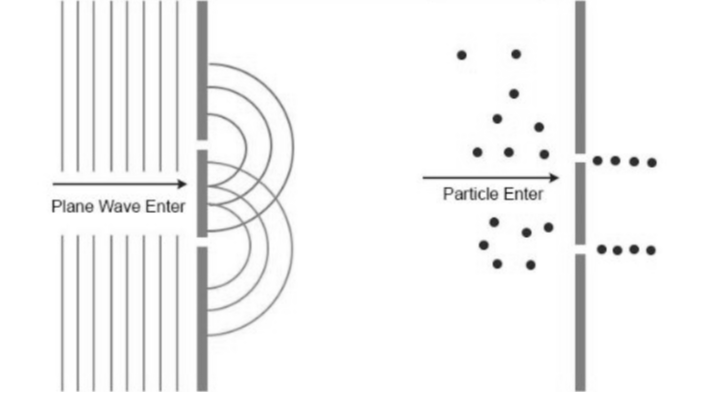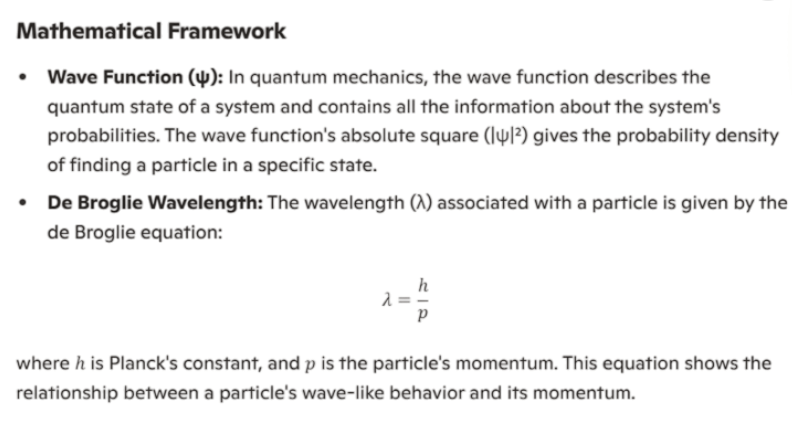Wave-Particle Duality
Wave-particle duality is a fundamental concept in quantum mechanics that states that all matter and energy exhibits both wave-like and particle-like properties. This means that particles,such as electrons and photons, can behave like waves, and waves can exhibit particle-like behavior.

This concept challenges our classical understanding of the universe, where we tend to categorize things as either waves or particles. Waves, like water waves or sound waves, are characterized by continuous oscillations and the ability to interfere with each other. Particles, on the other hand, are discrete entities with definite mass and position.
Historical Context
Thomas Young's Double-Slit Experiment (1801)
Initially demonstrated with light, Young's experiment showed that light could produce interference patterns characteristic of waves, suggesting its wave-like nature.
Albert Einstein's Explanation of the Photoelectric Effect (1905)
Einstein proposed that light also behaves as discrete packets of energy, called photons, when it interacts with matter. This particle-like behavior was critical in explaining the photoelectric effect, where light ejects electrons from a material.
Louis de Broglie's Hypothesis (1924)
De Broglie extended the duality concept to matter, proposing that particles such as electrons also have wave-like properties. This was later confirmed through electron diffraction experiments.
The Double-Slit Experiment
The double-slit experiment is one of the most iconic demonstrations of wave-particle duality. Here's how it works:
Setup
A light source or a beam of particles, such as electrons, is directed at a barrier with two closely spaced slits. A detection screen is placed behind the barrier to observe the resulting pattern.
Wave-Like Behavior
When light or particles pass through the slits without observation, they create an interference pattern on the screen, indicating wave-like behavior. Peaks and troughs of waves overlap, producing regions of constructive and destructive interference.
Particle-Like Behavior
When an observer tries to determine which slit a particle passes through, the interference pattern disappears, and the particles behave like classical particles, creating two distinct bands corresponding to the slits. This highlights the dual nature of quantum entities.

Implications and Applications
Wave-particle duality has profound implications for our understanding of the quantum world and has led to numerous technological advancements:
- Quantum Mechanics Foundation: The duality is central to the development of quantum mechanics, providing crucial insights into the behavior of particles at microscopic scales.
- Electron Microscopy: Exploits the wave nature of electrons to achieve ultra-high resolution imaging, allowing scientists to observe structures at the atomic level.
- Quantum Computing: Utilizes principles of wave-particle duality to process information in ways that classical computers cannot, leveraging the superposition and entanglement of quantum states.
Philosophical Implications
Wave-particle duality challenges classical notions of reality and forces us to rethink the nature of particles and waves:
Complementarity Principle
Introduced by Niels Bohr, this principle states that wave and particle aspects are complementary, both necessary for a complete description of quantum phenomena, but are mutually exclusive in any given measurement.
Nature of Measurement
The duality illustrates the importance of measurement in quantum mechanics, where the act of observing determines whether a quantum entity behaves as a wave or a particle.
Conclusion
Wave-particle duality is a cornerstone of quantum mechanics that reveals the complex and fascinating behavior of quantum entities. It demonstrates that particles such as electrons and photons do not fit neatly into the classical categories of waves or particles, but instead exhibit properties of both. Understanding this duality is essential for exploring the quantum realm and harnessing its potential for technological advancements.